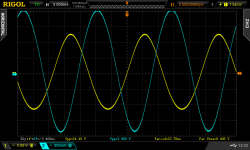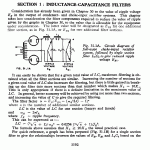Looking at the B+ is only half the story. You also need to check to what extent the amp gain varies with B+.
Ohm's Law and Kirchoff's two laws are very different animals. Ohm's Law is approximately true for many conductors (the 'ohmic' ones!) and not true for others (e.g. some semiconductors or semiconductor arrangements). It is not a law of nature.
That is not really an example. But since you touch on semiconductors, the refinement of Beta DC formulas are still needed in semiconductor theory.
Semiconductor theory is about band gaps and Fermi levels, arising from solutions to Schrodinger's equation with a periodic potential. Not sure where "Beta DC formulas" come in.
Are the goalposts moving?
Are the goalposts moving?
Here is a scope shot. To visualize what is happening.
GM70 Single Ended Amp. I'm going to say with a moderate amount of capacitance.
Power supply is 30uF>1.5H>135uF>1.5H>135uF Voltage at last cap 1060v
Blue trace is measured at the last 135uF cap.
Yellow trace is secondary of output transformer with 6.8 ohm load or about 10 watts continuous @42Hz (~low E on bass guitar)
GM70 Single Ended Amp. I'm going to say with a moderate amount of capacitance.
Power supply is 30uF>1.5H>135uF>1.5H>135uF Voltage at last cap 1060v
Blue trace is measured at the last 135uF cap.
Yellow trace is secondary of output transformer with 6.8 ohm load or about 10 watts continuous @42Hz (~low E on bass guitar)
Attachments
No, because quantum mechanics will not save you from the lack of knowledge of basic gain formulas.Semiconductor theory is about band gaps and Fermi levels, arising from solutions to Schrodinger's equation with a periodic potential. Not sure where "Beta DC formulas" come in.
Are the goalposts moving?
You tell me what you mean by the "basic gain formula" of "Beta DC" and I will tell you whether I have prior knowledge of this. If you simply mean the definition of DC current gain in a BJT then I have known such trivial things for many decades, and I can't see how that is relevant to this thread. I am beginning to think you are just trolling.
so there is two ways you can go filtering with c-l-c: high capacitance, low inductance or low capacitance and high inductance.
It is not the same thing. High L and low C will give high output impedance. High C and low L will give lower impedance, looking from the amp side of the supply.
At this respect, Mr Langford Smith in his "Radiotron" says, at page 1192 of chapter 31:
Please note that it is intended to be a good engineered device, and not necessarily a good "sounding" set, as "audiophiles" say.
Attachments
Interesting that it says that not much will be gained by going beyond two sections. We still regularly see newbies wanting to try four or five sections in a vain attempt to get very small ripple and hence very small hum; they don't realise that ripple and hum are often limited by other issues such as grounding and unwanted coupling.
Ripple is, of course, not the issue being discussed here but DavesNotHere might not realise this.
Ripple is, of course, not the issue being discussed here but DavesNotHere might not realise this.
I agree. The problem is (in my opinion), that nobody reads anything and believes that making a couple of sets mediocrily designed, using "audio grade" materials, they have sufficient knowledge to discuss 'till the Kirchhoff laws, or reinvent the wheel.
Those magnificent old books (Terman, Seely, Wallman, Gray) are full of well proved knowledge, with lots of maths and demonstration. Buy I believe few people nowadays can understand them. His limits are a poor PC simulation ignoring that simulations are only simulations.
I still prefer to read and learn and not to "try and cut", or worse, the new "Ctrl-C Ctrl-V" habit without knowing what do they paste, or from who.
Those magnificent old books (Terman, Seely, Wallman, Gray) are full of well proved knowledge, with lots of maths and demonstration. Buy I believe few people nowadays can understand them. His limits are a poor PC simulation ignoring that simulations are only simulations.
I still prefer to read and learn and not to "try and cut", or worse, the new "Ctrl-C Ctrl-V" habit without knowing what do they paste, or from who.
Four or Five sections of LC? That's a lot of pocket money. Thank goodness for mosfets.
Mosfet are reliable, but capable of shortciruit without previous advise. Inductors well designed rarely fault. Also, in my case, I make my own inductors and transformers.
Yes, I love the old textbooks too; they are much clearer in their explanations. I find the same thing with physics textbooks in well established topics. For instance, the Landau and Lifshitz books, about which so many students complain, are really beautifully written and clear when you can cope with the maths.
It is not the same thing. High L and low C will give high output impedance. High C and low L will give lower impedance, looking from the amp side of the supply.
At this respect, Mr Langford Smith in his "Radiotron" says, at page 1192 of chapter 31:

Please note that it is intended to be a good engineered device, and not necessarily a good "sounding" set, as "audiophiles" say.
still doesn't matter. You can build it with low capacitance, and high inductance or high capacitance and low inductance.
the first one has been the norm when tubes was a mainstream device.
classic design vs modern. but you guys are a waste of time.
You make your owns transformers; that's very impressive Osvaldo! How long does it take? Do you have a winding machine or have you improvised one with a lathe?
...but you guys are a waste of time.
Perhaps it may be more interesting search Pokemons in the cell that dialog about technical facts, or to read a book.
You make your owns transformers; that's very impressive Osvaldo! How long does it take? Do you have a winding machine or have you improvised one with a lathe?
Not, at hand. See my "High (Audio) Quality AM tuner" thread. Lots of pics, simulations, and explanations there. I'm currently working to improve still more this thread.
Only if ripple is the only consideration. It isn't. Impedance at a wide range of frequencies matters too.DavesNotHere said:still doesn't matter. You can build it with low capacitance, and high inductance or high capacitance and low inductance.
No, not classic vs. modern design. Informed vs. ignorant design, maybe. The Mods may wish to remind you of forum rules.classic design vs modern. but you guys are a waste of time.
No, not classic vs. modern design. Informed vs. ignorant design, maybe. The Mods may wish to remind you of forum rules.
Applause‼
- Status
- Not open for further replies.
- Home
- Amplifiers
- Tubes / Valves
- PSU with Choke for Loftin-White 2A3


